
Some say the world will end in fire,
Some say in ice.
From what I’ve tasted of desire
I hold with those who favor fire.
But if it had to perish twice,
I think I know enough of hate
To know that for destruction ice
Is also great
And would suffice.
–Robert Frost
After finishing this I felt a bit numb for several days. It is one of the darkest and most emotionally draining television series that I have ever watched. I found some of the scenes quite upsetting, but to be fair there were also some that were rather beautiful. And somehow or other the ending really got to me, so I guess I have to give it a positive recommendation, but with some strong caveats. It is very well done, but very dark and unsettling.
-
Original TitleX (EKKSU)
-
GenresFantasy, Drama, Adventure, Eschatology
-
DemographicShoujo
-
Contents25 Episodes on 8 (or 5) DVDs
-
LanguagesEnglish, Japanese with subtitles
-
Based onX/1999, a manga by CLAMP
-
DirectorYoshiaki Kawajiri
-
Animation StudioMadhouse
-
BroadcastWOWOW, 2001-2002
-
Region 1 PublisherGeneon
It’s hard to believe that this was created by the same people who were responsible for Cardcaptor Sakura, and in roughly the same time period. (The manga ran from 1992 to 2003, while CCS ran from 1996 to 2000.) CCS may have some dark undertones, but its fundamental outlook is hopeful and optimistic. X on the other hand is the sort of story where practically everyone seems to have some sort of Tragic Destiny. Whether you would like this series depends a lot on your tolerance for that sort of thing.
It would also depend on your ability to keep track of a large number of characters. There are seven primary heroes, plus seven villains, plus a leader for each group, plus a bunch of supporting characters several of which are fairly important to the story. If you can’t keep them straight then the story won’t make much sense.
The fantasy background is an eclectic mix. Start with a base of Japanese traditions and folklore; mix in some Christian ideas with an emphasis on the Book of Revelation; season to taste with bits of Kabbalah and Arthurian legends, then pour in some modern environmental mysticism. In the hands of many writers such a mixture of disparate sources would turn into a ridiculous mishmash, but it this case it fits together surprisingly well, though with some distortion of the original source material.
The quality of the artwork is very high, with many elaborate drawings. The powerful musical score adds to the effectiveness.
Parental Advisory
This series is not suitable for young children. It features bloody violence, disturbing scenes and tragic events. Teenagers should be able to handle it but may not enjoy it. It is probably best suited for older teenagers and adults.
DVD Info
In addition to the 24 episodes originally broadcast, the DVD version includes a prologue called “Episode 0” which fills in more of the backstory and provides a sort of preview of some of the main themes.
There have actually been two DVD releases in North America. The original release was on 8 DVDs. A later release called “X-Remix” fits the same episodes onto 5 DVDs (through the magic of double layers) and can be purchased in a very cool-looking black case.
The “Remix” includes a 5.1 channel version of the Japanese soundtrack which is well worth it if you have a home theater system. As usual I recommend listening to the Japanese soundtrack with subtitles due to the higher quality of the voice acting.
Other Versions
A movie version was shown in theaters in 1996. I haven’t seen it, but by all accounts the attempt to fit the story into 98 minutes was not very satisfactory. The movie version has an ending that is very different, and by the sound of it much worse.
Premise
 Seven of Tokyo’s major landmarks actually embody mystical barriers which protect the human world from catastrophe. Seven people are charged with the duty of protecting these barriers. These people are The Dragons of Heaven, also known as The Seven Seals.
Seven of Tokyo’s major landmarks actually embody mystical barriers which protect the human world from catastrophe. Seven people are charged with the duty of protecting these barriers. These people are The Dragons of Heaven, also known as The Seven Seals.
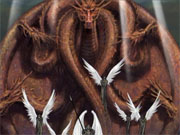 The Earth, apparently fed up with global warming, ozone depletion and other human depredations, has called forth a group of champions called The Dragons of Earth or The Seven Angels. Their job is to destroy the Tokyo barriers, thus triggering a series of catastrophes that will cause a mass extinction event, exterminating humanity (and apparently most other lifeforms.) After this the Earth will be able to be reborn, purified of bothersome humans.
The Earth, apparently fed up with global warming, ozone depletion and other human depredations, has called forth a group of champions called The Dragons of Earth or The Seven Angels. Their job is to destroy the Tokyo barriers, thus triggering a series of catastrophes that will cause a mass extinction event, exterminating humanity (and apparently most other lifeforms.) After this the Earth will be able to be reborn, purified of bothersome humans.
The Dragons of Earth are portrayed in a manner that is not unsympathetic, but what with wanting to kill everybody, they come off as a rather cold-hearted bunch and most viewers will naturally regard them as the bad guys.
A kekkai is a very convenient concept and it is not surprising that later writers have borrowed it. (E.g. similar ideas appear in Shakugan no Shana and The Melancholy of Haruhi Suzumia.) I don’t know whether the concept originated with X, but the writers devote so much screen time to explaining it that they clearly don’t think the viewers will be familiar with it.
It seems a safe generalization that while anime villains may sometimes be motivated by abstract ideals, heroes are primarily motivated by personal loyalties. In this case, even though the Dragons of Heaven are supposed to be protecting all of humanity, it is emphasized that they need to have some specific individual that they want to protect. This is actually a weakness, because failure to protect that individual is so traumatic that the Dragon of Heaven will not be able to continue fighting.
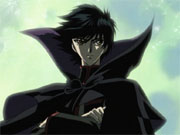 At the beginning of the story the Dragons of Heaven and the Dragons of Earth have only 6 members each. Both groups are reserving a place in anticipation of the prophecised arrival of The Kamui whose name means either “The One Who Fulfills the Will of God” or “The One Who Hunts the Will of God” (meaning he hunts the people who carry it out.) The Kamui will have to choose between the two groups, and his choice is expected to determine the outcome of the final battle.
At the beginning of the story the Dragons of Heaven and the Dragons of Earth have only 6 members each. Both groups are reserving a place in anticipation of the prophecised arrival of The Kamui whose name means either “The One Who Fulfills the Will of God” or “The One Who Hunts the Will of God” (meaning he hunts the people who carry it out.) The Kamui will have to choose between the two groups, and his choice is expected to determine the outcome of the final battle.
Characters
Roughly in order of appearance, starting with Episode 1…
 He may look like a juvenile delinquent, but Sorata Arisugawa (Dragon of Heaven) is actually a Buddhist monk from Mount Koya, the center of the Shingon sect.. He is cheerful, boisterous, mischievous and somewhat irreverent. His Osaka accent identifies him as the closest thing this series has to a comic character. He fights using ball lightning.
He may look like a juvenile delinquent, but Sorata Arisugawa (Dragon of Heaven) is actually a Buddhist monk from Mount Koya, the center of the Shingon sect.. He is cheerful, boisterous, mischievous and somewhat irreverent. His Osaka accent identifies him as the closest thing this series has to a comic character. He fights using ball lightning.
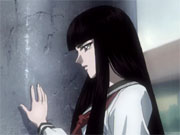 Arashi Kishyuu (Dragon of Heaven) is a miko from the Ise Shrine, one of the most sacred sites in the Shinto religion. She has a stern, severe demeanor and never smiles. She fights with a magic sword which she can materialize from her left hand.
Arashi Kishyuu (Dragon of Heaven) is a miko from the Ise Shrine, one of the most sacred sites in the Shinto religion. She has a stern, severe demeanor and never smiles. She fights with a magic sword which she can materialize from her left hand.
 Fourteen year old Yuzuriha Nekoi (Dragon of Heaven) is the youngest of the major characters. She is descended from the keepers of the Mitsumine Shrine, who apparently specialize in raising and training inugami (dog spirits). She is naive and full of bubbly enthusiasm. She is always accompanied by Inuki, her faithful guardian spirit.
Fourteen year old Yuzuriha Nekoi (Dragon of Heaven) is the youngest of the major characters. She is descended from the keepers of the Mitsumine Shrine, who apparently specialize in raising and training inugami (dog spirits). She is naive and full of bubbly enthusiasm. She is always accompanied by Inuki, her faithful guardian spirit.
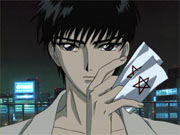 Subaru Sumeragi (Dragon of Heaven) is the young head of a family of onmyouji, practitioners of an esoteric school of magic known as onmyoudou. He is quiet and sad, haunted by memories of the past.
Subaru Sumeragi (Dragon of Heaven) is the young head of a family of onmyouji, practitioners of an esoteric school of magic known as onmyoudou. He is quiet and sad, haunted by memories of the past.
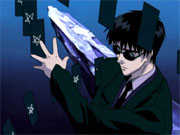 Seishirou Sakurazuka (Dragon of Earth) is the one-eyed leader of a family of ruthless assassins. Like Subaru he practices onmyoudou magic. He and Subaru were once close friends, but that relationship ended violently years ago.
Seishirou Sakurazuka (Dragon of Earth) is the one-eyed leader of a family of ruthless assassins. Like Subaru he practices onmyoudou magic. He and Subaru were once close friends, but that relationship ended violently years ago.
 Hokuto Sumeragi is Subaru’s elder sister, who was killed by Seishirou. She was cheerful and optimistic, but was less skilled than her brother in onmyoudou.
Hokuto Sumeragi is Subaru’s elder sister, who was killed by Seishirou. She was cheerful and optimistic, but was less skilled than her brother in onmyoudou.
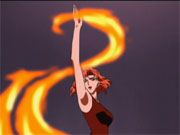 Karen Kasumi (Dragon of Heaven) is a firemaster, able to summon and control Fire. They don’t exactly say what she does for a living…but…well…it’s pretty clear that she’s a prostitute. She is also a devout, Bible-quoting Christian.
Karen Kasumi (Dragon of Heaven) is a firemaster, able to summon and control Fire. They don’t exactly say what she does for a living…but…well…it’s pretty clear that she’s a prostitute. She is also a devout, Bible-quoting Christian.
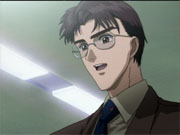 Seiichirou Aoki (Dragon of Heaven) is an editor for a large Tokyo publishing company. He is a windmaster, with power over Wind similar to Karen’s power over Fire.
Seiichirou Aoki (Dragon of Heaven) is an editor for a large Tokyo publishing company. He is a windmaster, with power over Wind similar to Karen’s power over Fire.
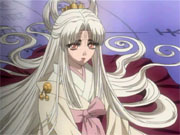 Princess Hinoto is the effective leader of the Dragons of Heaven; they rely on her for advice and guidance. She is blind, deaf, mute and unable to walk, but able to communicate telepathically. As a yumeni or dreamseer, she can see distant or future events in her dreams. From her headquarters beneath the Diet (parliament) Building she controls much of what goes on in Japanese politics. Years of being able to foresee the future, but not being able to change it in any significant way, have left her deeply depressed.
Princess Hinoto is the effective leader of the Dragons of Heaven; they rely on her for advice and guidance. She is blind, deaf, mute and unable to walk, but able to communicate telepathically. As a yumeni or dreamseer, she can see distant or future events in her dreams. From her headquarters beneath the Diet (parliament) Building she controls much of what goes on in Japanese politics. Years of being able to foresee the future, but not being able to change it in any significant way, have left her deeply depressed.
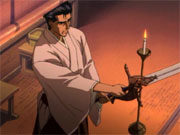 Kyougo Monou is the resident priest at the Togakushi Shrine near Tokyo. He is charged with protecting the shinken (Divine Sword) which is supposed to be wielded by the Kamui.
Kyougo Monou is the resident priest at the Togakushi Shrine near Tokyo. He is charged with protecting the shinken (Divine Sword) which is supposed to be wielded by the Kamui.
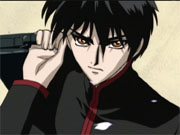 Kamui Shirou is a rather unpleasant young man with tremendously destructive magical powers and a bad attitude. He is dark, brooding, cold and unfriendly. He has just returned to Tokyo after living in Okinawa for six years.
Kamui Shirou is a rather unpleasant young man with tremendously destructive magical powers and a bad attitude. He is dark, brooding, cold and unfriendly. He has just returned to Tokyo after living in Okinawa for six years.
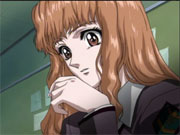 Kyougo’s daughter Kotori Monou is increasingly troubled by dreams that seem to accurately predict the future. She and Kamui Shirou were childhood friends before he moved to Okinawa. In fact he once saved her life with an incredible feat of strength and endurance. Now she is surprised and hurt by his cold behavior.
Kyougo’s daughter Kotori Monou is increasingly troubled by dreams that seem to accurately predict the future. She and Kamui Shirou were childhood friends before he moved to Okinawa. In fact he once saved her life with an incredible feat of strength and endurance. Now she is surprised and hurt by his cold behavior.
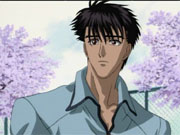 Back when Kamui saved Kotori’s life, her older brother Fuuma Monou swore that he would always protect Kamui when he needed it. Fuuma is tall, handsome and athletic, with a kind and helpful personality.
Back when Kamui saved Kotori’s life, her older brother Fuuma Monou swore that he would always protect Kamui when he needed it. Fuuma is tall, handsome and athletic, with a kind and helpful personality.
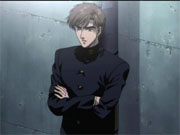 Daisuke Saiki is Seiichirou Aoki’s nephew, and like him is a windmaster, though less powerful. He works for Princess Hinoto and is fiercely loyal to her.
Daisuke Saiki is Seiichirou Aoki’s nephew, and like him is a windmaster, though less powerful. He works for Princess Hinoto and is fiercely loyal to her.
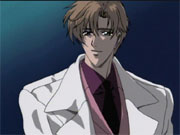 Yuuto Kigai (Dragon of Earth) is a watermaster, but he also fights with a long whip and a three-bladed dagger. He is a cheerful unflappable fellow who watches the events of the story with grim amusement. He works as a bureaucrat for the city government.
Yuuto Kigai (Dragon of Earth) is a watermaster, but he also fights with a long whip and a three-bladed dagger. He is a cheerful unflappable fellow who watches the events of the story with grim amusement. He works as a bureaucrat for the city government.
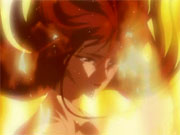 One reason why Kamui has such a negative attitude is that he has just witnessed the death of his mother Tohru Magami in a house fire. The members of the Magami family have the ability to act as kagenie (shadow sacrifices), giving up their own lives to save another person. Tohru chose to sacrifice herself in order to save Kamui from some unspecified doom.
One reason why Kamui has such a negative attitude is that he has just witnessed the death of his mother Tohru Magami in a house fire. The members of the Magami family have the ability to act as kagenie (shadow sacrifices), giving up their own lives to save another person. Tohru chose to sacrifice herself in order to save Kamui from some unspecified doom.
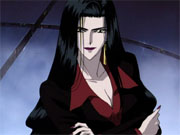 Princess Hinoto’s younger sister Kanoe performs a similar role in organizing and guiding the Dragons of Earth. She is not a dreamseer, but she can enter the dreams of others, which seems almost as useful and less depressing. She works as a secretary for the Governor of Tokyo.
Princess Hinoto’s younger sister Kanoe performs a similar role in organizing and guiding the Dragons of Earth. She is not a dreamseer, but she can enter the dreams of others, which seems almost as useful and less depressing. She works as a secretary for the Governor of Tokyo.
 Satsuki Yatouji (Dragon of Earth) is a computer genius with the power to control all types of electronic equipment. She is cold and rational and contemptuous of ordinary humans. She spends most of the time hooked up to a supercomputer mecha called The Beast (you can probably guess the model number) which gives her access to all the world’s computer systems.
Satsuki Yatouji (Dragon of Earth) is a computer genius with the power to control all types of electronic equipment. She is cold and rational and contemptuous of ordinary humans. She spends most of the time hooked up to a supercomputer mecha called The Beast (you can probably guess the model number) which gives her access to all the world’s computer systems.
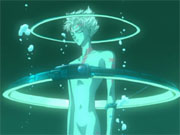 Nataku (Dragon of Earth) is the product of a highly unethical experiment in cloning and genetic manipulation. “He” is sexless and apparently without emotions. He fights using magic scarves that can enfold and strangle his opponents. (He is sometimes called Kazuki.)
Nataku (Dragon of Earth) is the product of a highly unethical experiment in cloning and genetic manipulation. “He” is sexless and apparently without emotions. He fights using magic scarves that can enfold and strangle his opponents. (He is sometimes called Kazuki.)
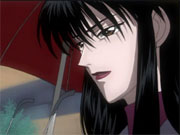 Kamui’s aunt Tokiko Magami claims to have an important secret to reveal to him.
Kamui’s aunt Tokiko Magami claims to have an important secret to reveal to him.
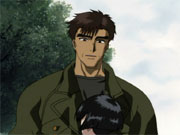 Kusanagi Shiyuu (Dragon of Earth) is a soldier with the Japanese Self-Defense Forces. Despite his rough appearance he is a sensitive man, able to feel the suffering of the Earth. He has the power to cause earthquakes.
Kusanagi Shiyuu (Dragon of Earth) is a soldier with the Japanese Self-Defense Forces. Despite his rough appearance he is a sensitive man, able to feel the suffering of the Earth. He has the power to cause earthquakes.
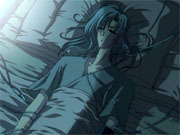 Kakyou Kazuki (Dragon of Earth) lies in a hospital bed, apparently in a coma, but his mind is active. Like Princess Hinoto he is a dreamseer, able to see the future in his dreams, and like her he is very depressed. He is sustained only by his memories of Hokuto, but he is tormented by the fact that he foresaw her death but was unable to keep Seishirou from killing her.
Kakyou Kazuki (Dragon of Earth) lies in a hospital bed, apparently in a coma, but his mind is active. Like Princess Hinoto he is a dreamseer, able to see the future in his dreams, and like her he is very depressed. He is sustained only by his memories of Hokuto, but he is tormented by the fact that he foresaw her death but was unable to keep Seishirou from killing her.
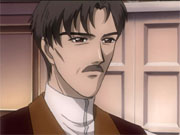 Nokoru Imonoyama is the Chairman of CLAMP Campus, a giant educational institution that seems to guard some occult secrets. (This is about as close as we will get to seeing CLAMP’s usual whimsy.)
Nokoru Imonoyama is the Chairman of CLAMP Campus, a giant educational institution that seems to guard some occult secrets. (This is about as close as we will get to seeing CLAMP’s usual whimsy.)
Links
Anime News Network entry.
Wikipedia article (Major spoilers.)


Arrrgh. First Magic Knight Rayearth, and now this. It looks like I am eventually going to have to watch all the CLAMP anime.
Heh, poor Don.
I only saw X the movie (on a celluloid film, no less), and by now I do not remember a single frame. My subconsciousness erased it completely. I only remember that it was absolutely the worst feature length anime I have ever watched.